Original URL: https://www.theregister.com/2008/12/10/review_desktop_pc_shuttle_x27d/
Shuttle X27D
Nice CPU. So why the poor chipset?
Posted in Personal Tech, 10th December 2008 14:40 GMT
Review We had something of a downer on the Intel Atom 230 as the single-core 1.6GHz processor could barely pull the skin off a rice pudding.
Our verdict was that "you can build an incredibly small and cheap PC around the D945GCLF mobo, but the Atom CPU is a severe disappointment on the desktop as it doesn’t have the grunt to do any useful work". And we hoped that "perhaps the next-gen, dual-core Atom will make a world of difference".
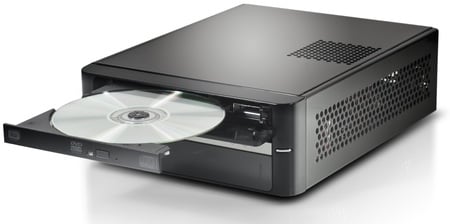
Shuttle's X27D: dual-core Atom on board
With the launch of Atom 330, we’ve got our hands on a Shuttle X27D - D for 'dual core' - which is very similar to the Intel D945GCLF motherboard that we originally reviewed. The only significant difference is the move from the one cored Atom 320 to the two-core 330 and yes, we are aware that Atom uses Hyper Threading to double up the number of virtual cores.
Shuttle has finished production of the X27 and has switched over to the X27D without changing the price from £199 for a barebones - which we think is jolly civil of it. If you want to buy the X27D as a PC, you’ll find it on sale online with prices starting at £321 for a complete system without OS, in case you fancy using Linux instead of Windows XP or Vista. The model code changes when you’re looking at a full PC instead of a barebones from Shuttle Barebone X27D to Shuttle X2700B Mini-PC System.
Building a Shuttle barebones is usually quick and easy as most models use regular desktop parts. The tiny X27D chassis only measures 250 x 185 x 70mm and uses a laptop hard drive and optical drive, although the single module of DDR 2 system memory is a desktop DIMM. That’s a nice cheap place to start as 2GB of PC2-5300 will only cost £20.
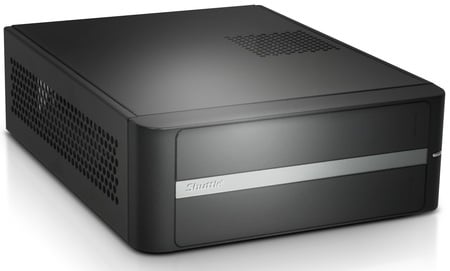
Not expensive to equip
Add in a 160GB notebook hard drive for £40 and the final piece of hardware is the optical drive. A basic DVD writer costs £25 and you may consider spending another £125 to add Blu-ray, but we strongly recommend against this course of action. The Intel GMA950 integrated graphics don’t have the grunt to handle HD playback, and the Atom 330 can't pick up the slack.
We watched some Apple QuickTime HD 720p movie previews and found that the CPUs were only loaded to 50 per cent but playback was still jerky, presumably thanks to the Intel graphics. The Bios gives a choice of dedicating 1MB or 8MB of memory to the graphics so we plumped for the full 8MB but it made no noticeable difference.
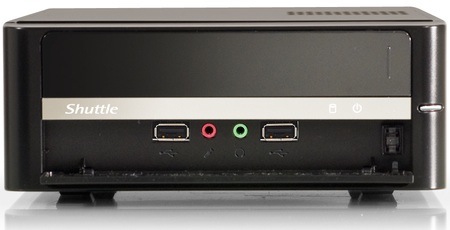
Basic header ports...
Indeed, the graphics are so weak that the DVI-I output requires a dedicated Silicon Image chip so don’t, for Heaven’s sake, think of the Shuttle X27D as a Media Centre.
Although it is small and near-silent, the Shuttle doesn’t have the cojones for that particular job. What we’re looking at is a regular PC that will appeal to the sort of people who hate a beige tower and have no desire to play games. That covers PC users who want the desktop equivalent of a netbook only with a proper mouse, keyboard and display, which reminds us that you also need to budget for those peripherals, along with a set of speakers.
The upshot is that the Shuttle X27D is a relatively expensive PC and it’s not difficult to argue that it places form above function. Hmm, where have we seen that before?
If you go for the X27D, you’ll find that assembly isn’t especially difficult but it took us a couple of goes to get the hard drive in the correct position so we could route the tiddly SATA cable properly. We don’t have any spare laptop DVD drives here so we had to cheat and use a regular desktop SATA drive that we laid on the bench.
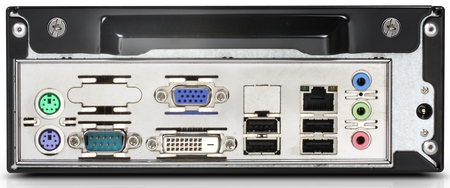
...but plenty more on the back
The alternative is to buy a pre-built system from the likes of Ambros or PCMeisters who offer the option of ‘Modest Overclocking – Free of Charge’
3DMark06 Results
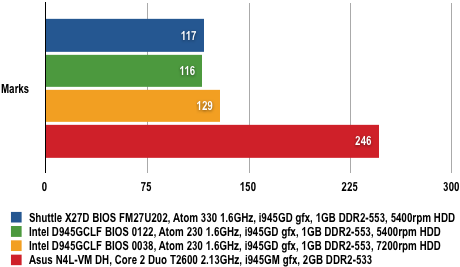
Longer bars are better
PCMark05 Results
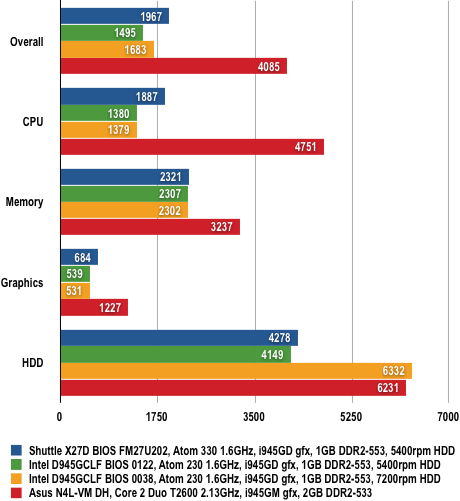
Longer bars are better
Power Draw Results
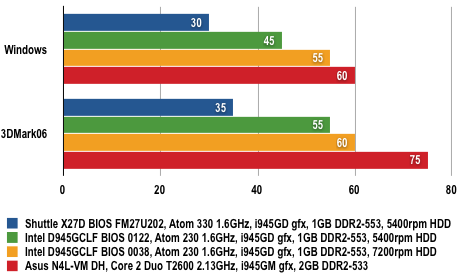
Power draw in Watts (W)
The finished PC is small and smart with two USB ports and jacks for a head set concealed behind a flap on the front of the case, with a second flap covering the DVD drive. There are more audio jacks on the back of the Shuttle as well as four more USB 2.0 ports, Gigabit Ethernet, video outputs, two PS/2 ports and, strangely, a serial port.
Performance is perfectly decent for a desktop PC but the benefit of the dual-core Atom is that Windows keeps chugging along when you open browser windows and movie players where Atom 230 struggled.
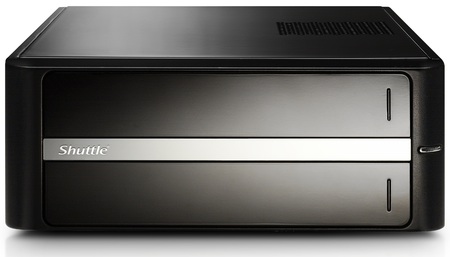
Good media centre? Er... no
The real success of the X27D is the near absence of noise. The external power brick is smaller than the unit you get with most laptops and the only moving part inside the case is the 40mm fan on the chipset cooler.
This brings us, once again to the Achilles Heel of Atom, at least on the desktop. We’re all in favour of small, cheap, low, cool and quiet processors for people who have no need of a 3GHz quad-core PC. The problem for Atom is chipset support. The Intel 945GC is past its sell-by date, and the GMA950 graphics are a serious restriction for all manner of tasks. A move to a modern chipset, such as G45, would boost performance across the board and would very likely do away with the need for an active cooler.
That sounds like a win-win-win to us, so the news that Nvidia may add support for Atom to its GeForce 9400M chipset is welcome.
In the meantime., we have warmed to Atom with the 330 update but fervently hope that Intel gives its baby CPU the chipset support that it deserves.
Verdict
Shuttle has done its best with Atom 330 and has left prices unchanged but it is severely hampered by the Intel 945GC chipset. As things stand, we're neutral on Atom for the desktop but we look forward to the next chapter in this story.
More Reviews...
Dell Studio Hybrid |
Asus Eee Box |
Atom 230 |
VIA Nano |